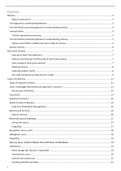Notas de lectura
Memory
- Grado
- Institución
Study/lecture notes for first-year psychology on memory *Please note that the information in the document is not my own knowledge, it belongs to the Unversity of the Witwatersrand and is comprised of notes from lectures and textbooks.
[Mostrar más]




